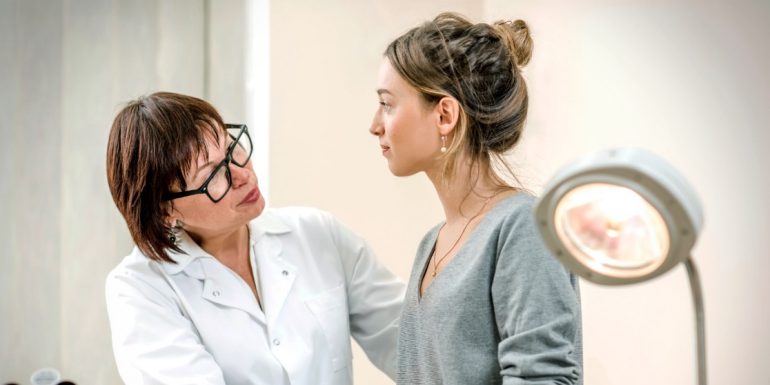
How the menstrual cycle works
If you know your cycle, you can take advantage of the different phases. You can plan your diet, exercise and daily routine better and adapt them over the course of the month.
The menstrual cycle is a perfectly designed plan to prepare the body for fertilisation. Nature is lavish with women’s fertility: every month a new nest is created in the womb.
Both ovaries contain approximately 500,000 eggs each at birth. From puberty onwards, 5 to 15 eggs mature per ovary per month. In most cases, only one of them ovulates. During the course of a cycle, the body’s cocktail of hormones changes continuously. It begins on the first day of the menstruation and ends a day before the next period.
How long does a cycle last?
A 28-day cycle is regarded as normal. However, only a few women have cycles that last exactly that long. In science, cycles with a length of 24–36 days are characterised as healthy cycles.
The four phases of the menstrual cycle explained simply
The menstrual cycle begins on the first day of menstruation. During this phase, the womb lining which has built up is discharged as a period. Menstrual blood is a mixture of this lining, mucus and some blood.
Good to know: Resting phase
Your body is shedding in this phase and preparing for the cycle. This drains your energy. In addition, this is often accompanied by period pains and bleeding. Give your body the time it needs. A walk in the woods, a warm bath, snuggling up on the sofa with a book – whatever it is, make sure to be good to yourself.
During the follicular phase, oestrogen levels increase and the body produces more of the happy hormones serotonin and dopamine. Many women experience a high level of energy and feel particularly good about themselves during this phase.
Then, the body begins to produce oestrogen again under the influence of follicle-stimulating hormone (FSH). This is the signal for the womb lining to slowly become thicker again. Simultaneously, the follicles mature in the ovaries. The level of progesterone (corpus luteum hormone) also increases: it prepares the womb lining for the implantation of a fertilised egg.
Good to know: The energy booster
Your hormones are on your side: your skin and hair look good. Your trousers fit. Everything feels easier. The increasing oestrogen levels make you feel more attractive and help you to concentrate better. You may even lose weight in this phase, as you automatically want to eat healthier, low-calorie food.
The luteinizing hormone (LH) triggers ovulation. At this time, a follicle in one of the ovaries is usually fully mature and viable. The body then releases the egg into the Fallopian tube. It is able to be fertilised there for approximately 12–24 hours. Under the influence of oestrogen, the cervical mucus becomes more fluid, enabling sperm cells to penetrate it better and reach the Fallopian tubes. As they can survive for up to five days in a woman’s body, the fertile window lasts approximately six days.
Good to know: Desire for testosterone during ovulation
A man’s sweat: at other times in your cycle, you are more likely to perceive it as an unpleasant smell, but around ovulation you may find it arousing. This breakdown product of the male sex hormone testosterone acts as an attractant during this time.
Under the influence of the luteinizing hormone, the embryonic membrane remaining in the ovary forms the corpus luteum. It maintains the level of progesterone for some time. The next development of the phase depends on whether the egg is fertilised or not:
- The egg is not fertilised
The egg dies. The cervical mucus becomes thicker again. Simultaneously, the corpus luteum degenerates, progesterone production decreases, the womb lining begins to disintegrate and is finally shed. Menstruation occurs and a new cycle begins. - The egg is fertilised
The fertilised egg divides several times on the way to the womb and implants in the womb lining. This is still in place and the corpus luteum continues to produce progesterone. The placenta takes over nutrition in the later course of the pregnancy. The concentration of oestrogen and the pregnancy hormone hCG increases. The next period never comes – and new life grows in the womb.
In the luteal phase, the hormone progesterone causes your appetite to increase significantly. This is completely normal, however, as calorie consumption or basal metabolic rate increases by up to 10% during this period. Fruit, vegetables, fish, nuts and wholegrain products help to balance your hormones.
PMS: when hormones go haywire
In a regular 28-day menstrual cycle, ovulation occurs on the 14th day of the cycle. You need to know the first day of your last period in order to calculate the fertile days. We recommend noting down the first day of each period for several months to calculate monthly ovulation. White discharge is also an indication of fertile days. It facilitates the passage of sperm cells and extends their life.
Our health advisors can provide you with useful information.
What are the causes of an irregular cycle?
There can be many different reasons behind an irregular cycle. Fatigue, a lack of sleep and stress are common causes.
Or have you recently gained or lost a lot of weight? Significant weight changes can disrupt the menstrual cycle. Being overweight increases oestrogen production and can lead to irregular periods – with heavier bleeding and a longer duration. If you are underweight, the body produces no more reproductive hormones and menstruation stops.
If you often experience severe pain or additional symptoms, such as bleeding or cramping between menstruation, it is best to seek medical advice to identify the cause. Possible reasons include:
- Endometriosis
- Ovarian cysts, fibroids or polyps
- Thyroid problems
- Uterine cancer
Which hormones play a key role in the menstrual cycle?
During the menstrual cycle, several processes take place in the body at the same time: follicles containing eggs mature in the ovaries. After ovulation, the corpus luteum develops from one of them. Simultaneously, the womb lining is first broken down and then reformed. Hormones control the processes and each one plays a separate role:
It stimulates the production of oestrogen in the ovaries in women and sperm production in men.
Together with other hormones, this regulates the menstrual cycle in women of childbearing age. It triggers ovulation. It also promotes the development of the corpus luteum from the residual follicle.
The female sex hormone is produced in the ovaries and fat tissue. It controls the sequence of the cycle, the maturation of egg cells and fertility. During menopause, oestrogen levels sink because the ovaries stop functioning. This often leads to disruptions in the menstrual cycle, hot flushes and vaginal dryness.
Progesterone, also called the corpus luteum hormone, changes the womb lining, which has been prepared by oestrogen, so a fertilised egg can implant there. Progesterone promotes the growth of the womb and prepares the breasts for nursing. If pregnancy does not occur during a cycle, the progesterone level drops rapidly and the period begins. This can lead to disturbed sleep, bad moods, irritability and anxiety. The hormone is used for contraception and to stop heavy menstrual bleeding.
The “happy hormone” is responsible for our mood swings. Particularly in the fourth phase of the cycle, it often decreases, and increases the desire for carbohydrates, such as pasta, bread and cake. Carbohydrate-rich food in turn can make you feel emotionally vulnerable – a vicious circle.
As a pregnancy-maintaining hormone, it relaxes the womb lining to facilitate implantation of the fertilised egg. It supports the placenta until this can carry out its intended function.
How many menstrual cycles does a woman have?
Scientists have found that women today have three times as many menstrual cycles as they did 250 years ago. At that time, women in Western Europe menstruated on average 150 to 160 times. Today, in the same region, they menstruate 450 to 480 times.
The reason for this is that people are better nourished today and girls therefore have their first menstruation, also called menarche, between the ages of 9 and 14. In addition, women today get pregnant later and then have only 1.5 children on average – instead of 10 to 15 as in the past.

The expert provided the editorial team with advice and input for this article. Nadia Cifarelli (BSc Psychology, certified holistic health advisor) works for the Helsana health consultation service. She helps customers on issues to do with prevention, nutrition and mental health.


Newsletter
Find out more about current health issues every month and get all the information you need about our attractive offers from all Helsana Group companies * delivered by e-mail to read whenever it suits you. Our newsletter is free of charge and you can sign up here:
- Ms
- Mr
We did not receive your information. Please try again later.
* The Helsana Group comprises Helsana Insurance Company Ltd, Helsana Supplementary Insurances Ltd and Helsana Accidents Ltd.